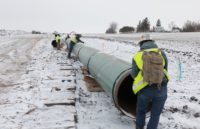Energy Policy
Officials, Oil-Gas Execs Spar on Energy Transition Speed and Breadth

U.S. Energy Secretary Jennifer Granholm touted the need for American dominance in clean energy as well as in oil and gas production to thousands of sector managers at Houston mega-conference on March 18.
Photo by Mark Felix/AFP via Getty Images
U.S. Energy Secretary Jennifer Granholm walked a fine line touting American dominance in both clean energy and fossil-fuel development to more than 8,000 global sector experts, mostly oil and gas industry managers, at mega conference CERAWeek by S&P Global, which began March 18 in Houston.
“The world will need secure supplies of traditional and renewable energy for the immediate future,” she told attendees. “These truths are not in conflict." Even as the world's leading oil and gas producer and largest LNG exporter, expansion of U.S. dominance in clean energy "is striking,” Granholm said.
According to the Dept. of Energy chief, clean energy investment is now 65% higher globally than for fossil fuel, and it has tripled in the U.S. since 2016. Companies now allocating billions of dollars into renewable energy investment “are not making these choices out of charity or because they're nice to have,” she said. “They're doing it because their bottom lines demand it.”
But Granholm also acknowledged that the current realities of the global energy transition and current geopolitical events have put “energy security … back on the table,” adding that “national security and energy security are inextricably bound.”

Bechtel "has a record high number of studies and jobs in development," in such areas as E-fuels, pumped hydro, hydroelectric, blue
ammonia and liquid-to-chemicals processes, President and COO Craig Albert (center) told big Houston energy conference attendees in mid March.
Photo courtesy of Bechtel
Several oil and gas firm CEOs spoke of more investment in renewable energy, hydrogen and other low- to zero-emission technologies, but emphasized continued oil and gas development.
Arshad Mansoor, CEO of the Electric Power Research Institute, noted the need for a broad approach to power generation, citing growing demand from data centers, cryptocurrency and electric vehicles. “You have to be a realist in this ambitious goal for a net-zero future, and realism is keeping the lights on,” he told S&P Global in a conference interview.
“The world will need secure supplies of traditional and renewable energy for the immediate future. These truths are not in conflict." But expansion of U.S. dominance in clean energy "is striking.”
—US Energy Secretary Jennifer Granholm
Bechtel President and COO Craig Albert said the contractor "has a record high number of studies and jobs in development," in such areas as E-fuels, pumped hydro, hydroelectric, blue ammonia and liquid to chemicals processes. "There's just an amazing amount of work that's in the front of the pipeline, and that kind of gives an indication of what is going to be added ... in parallel with LNG,” a major U.S. market for the contractor.
Pointing to "a lot of customer risk," in new areas, Albert noted need for "regulatory and rule certainty, the right types of tax credits" and government financial support if a clean energy market "is not quite mature yet," he said. "We believe that thoughtfully incentivizing the free market is the best way to create a driving force for the change that’s desired," Albert said.
Executives also predicted that growth in artificial intelligence could be a singular propellant in need for oil and gas-fueled power, said a Bloomberg report.
Despite the International Energy Agency's forecast that oil and gas demand will peak in 2030, Amin Nasser, CEO of oil producing giant Saudi Aramco, told attendees that it was “fantasy” to consider phasing out fossil fuel development—claiming oil needs of developing nations will delay peak demand until 2045, citing OPEC statistics.
He called for ramped up efforts to reduce carbon emissions and lower carbon solutions, but also continued oil and gas investment, “reflecting realistic demand assumptions.”
Geothermal Energy Heats Up
Granholm also announced a new federal push for geothermal energy development, “harnessing the … heat beneath our feet, and cracking the code to deploy [it] at scale.”
Stressing the “enormous potential,” of geothermal energy, she said that “all federal oil and gas leases can be converted to it without new permits” and characterized the market as “at least a $250 billion investment opportunity, to meet the goal of 90 gigawatts of power capacity by 2050,” about 20 times more than exists now.
Her comments follow DOE’s recent announcement of $74 million from the 2021 infrastructure law to fund up to seven pilot projects to demonstrate scalability of enhanced geothermal systems in areas where development for power, hearing and cooling “was thought to be impossible,” said Granholm. The agency anounced up to $40 million to support two enhanced geothermal systems projects, one led by Chevron New Energies in California and the other by Fervo Energy in Texas.
While studying the effects of booming LNG export under the recent DOE export approval pause is “understandable, there is likely a better way to navigate the issue.”
—Mike Wirth, CEO, Chevron
Chevron CEO Michael Wirth told CERAWeek attendees that the firm and others are experimenting with fracking and horizontal drilling to tap less-favorable geologies for geothermal. He said its U.S. pilot project, and one in Japan, could help determine if geothermal is technically and economically feasible and whether it could have unintended consequences.
DOE will host a webinar April 12 to provide further information on its geothermal power commercialization strategy, with first-round applications for pilot funding due June 16.
Legislation also was introduced in the U.S. Senate March 14 that its bipartisan sponsors say would streamline the environmental review process for geothermal projects and advance development on federal lands.
Large geothermal energy arrays have been installed in large residential projects in New York City, and recently in tech giant Microsoft’s new 72-acre corporate campus in Washington state to include more than 900 connected geo-wells drilled to a depth of 550 ft.
LNG Export Pause End Date
The issues surrounding DOE’s decision in January to pause permit approvals for LNG export projects in the U.S. was a hot conference topic. While studying the effects of booming LNG export is “understandable, there is likely a better way to navigate the issue,” said Chevron's Wirth. He said the ban signals U.S. unreliability as a global gas supplier.
In a March 18 letter to agency leaders and John Podesta, Biden's senior advisor on global climate policy, a coalition of Senate Republicans and oil and gas trade groups refuted White House claims that LNG harms the environment, raises the price of domestic natural gas and could leave U.S. allies without needed supplies.
“Halting U.S. LNG export approvals gives Russia the upper hand,” the letter said.
Granholm said the pause “does not touch” current U.S. exports of 14 billion cu feet (bcf) per day, 12 bcf now under construction and another 22 bcf that is authorized but awaiting final investment decision. She also said DOE would end the pause by March 2025—the most specific public reference yet to a termination date, media reports said.
Sen. Joe Manchin, the West Virginia Democrat who chairs the Senate Energy and Natural Resources Committee, expressed concern over permitting delays that hamper projects needed to reinforce energy security. Without sharing specifics, he said he hopes to finalize new permit reform legislation before the August congressional recess.
“There's work that's going on,” said Manchin, who is not seeking reelection and ends his current term in January. “I don't want to build up anybody’s anticipation or hope, but we are so close.”
In his CERAWeek appearance, Podesta said the administration has done “everything we could do” to speed up permitting, including use of $1 billion in Inflation Reduction Act funding to strengthen federal review staff and $300 million for improved processes in states.
Granholm noted a DOE pilot program getting underway to use AI to speed up permit times.
Despite criticism of U.S. Treasury proposed rules to access the law's green hydrogen incentives, tax credits are “being eaten voraciously as a big carrot,” she said, and have boosted reshoring of U.S. manufacturing.
Granholm also told attendees of a new DOE initiative to add federal benefits to communities that have been affected by emissions from traditional energy facilities, including millions in funding for carbon reduction and clean energy projects, particularly in Texas and Louisiana. She cited research that a lack of community engagement “is a huge contributor to project failure—a factor in almost 30% of failed projects.”
Granholm said: “We in this room have power to provide opportunities for communities and investors."




